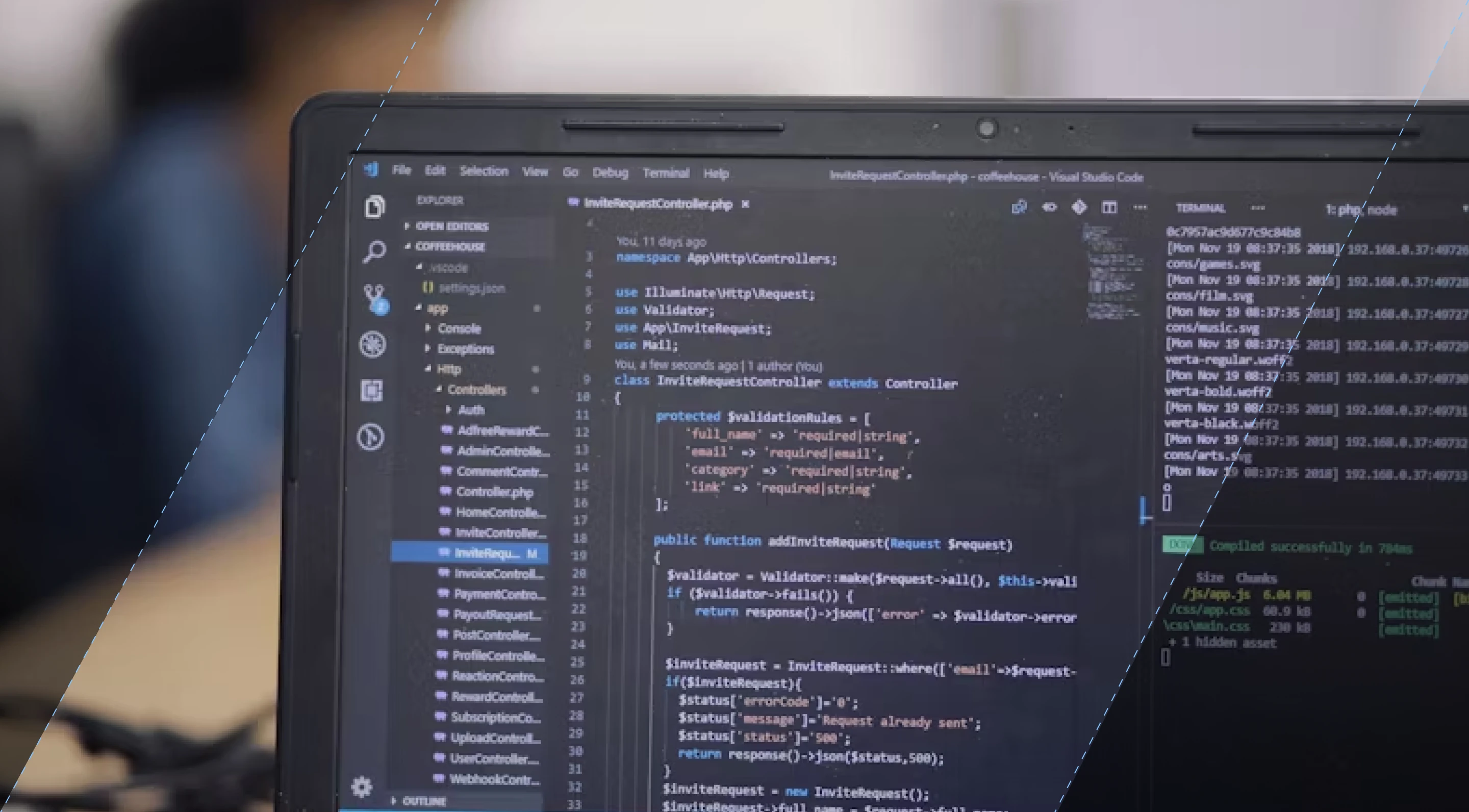SHARE
Most Popular Backend Frameworks in 2025

Contents
Contents
Introduction
The user of a software app will often see the software as a cohesive experience. But what they are interacting with is simply the user interface (UI).
This outward-facing frontend, or “client-side”, view hides the real work that modern software applications are doing behind the scenes. The backend, or “server-side”, functionality is often just as important for a useful and secure application experience.
Let’s look at what software developers are currently using as popular backend frameworks. Making the right choice here can make a big difference when it comes to performance, app scalability, and overall user satisfaction.
What is a Backend Framework?
A backend framework is a software framework that provides tools and libraries for developing the server side of web applications. The purpose of a backend framework is to support the developer in adding logic and functionality to an app or website.
In other words, the front-end controls what the software looks like and the back-end controls what the software does and how it does it.
Backend frameworks help developers build web applications more efficiently by providing pre-built components and libraries for common tasks.
What are the Benefits of Using a Backend Framework?
One of the greatest benefits of using a backend framework is the deduplication of work. Using a backend framework, the software builder doesn’t have to reinvent the wheel with each program.
For example, multiple programs may have similar functions that are handled through similar blocks of code.
Whether it is managing user authentication, analyzing data, delivering data to the front-end to display to the user, or processing secure payments, backend frameworks give backend development coders a head start on the coding process.
Without backend web frameworks, building web applications would become a significantly more lengthy and complicated process.
Every framework relies on a particular programming language. The language known and used by web developers will probably play the largest part in deciding which backend framework to employ.
However, within a particular programming language, there are often options that may make one framework stand out above its counterparts.
For more insights on frontend and backend frameworks, explore our detailed Object Oriented Programming vs. Functional Programming.
List of the Top Backend Frameworks
Consider some of the most popular backend frameworks that are currently being used to bring software and websites to the market today. In doing so, you may just find a technology that can assist you in your next web development project.

Ruby on Rails – Ruby Framework
Ruby on Rails, a popular backend framework built on the Ruby programming language, is widely embraced for its adherence to the Model-View-Controller (MVC) architecture and its emphasis on convention over configuration. This approach simplifies the development process, allowing Ruby on Rails developers to concentrate on business logic rather than getting bogged down by boilerplate code.
This allows developers to focus on business logic – what the program does – rather than boilerplate code that can bog backend developers down.
Ruby on Rails is considered an easy language to learn and, therefore, Rails is an easy framework to learn. It also has a large community and an abundance of plugins and libraries available.
The one drawback is that Ruby performs slower than languages like Java or Python and their respective frameworks. So, companies tend to migrate to higher-performance languages as they scale up.

Django – Python Framework
Django is a Python-based backend framework that is known for its scalability and versatility. It provides a high-level abstraction of common web development tasks, allowing developers to focus on business logic rather than the mundane, repetitive code.
Django also includes an object-relational mapping (ORM) system, which makes it easy to interact with databases like SQLite, MySQL, PostgreSQL, and Oracle.
The Django framework forces programming best practices and lets developers work completely within the framework, which can be useful for those just starting. Therefore, it can be used for rapid development to create web applications.

Flask – Python Framework
Flask is another Python programming language backend framework that is known to be simple, lightweight, and modular. Its structure allows developers to choose only the components they need.
Flask also has a small footprint, making it ideal for building lightweight applications. It is a micro web framework written in Python.
It doesn’t rely on particular tools or libraries and has no database abstraction layer, form validation, or other dependency components built-in.
But, it has numerous extensions you can use to add more functionality should you need it.

Express.js – JavaScript Framework
Express.js is a minimalist web framework for Node.js, which is built on JavaScript. It provides a simple and unopinionated structure that allows developers to customize their applications to their specific needs.
Express.js is also known for its speed and scalability, making it a popular choice for building high-performance web and mobile applications. Express.js is the most popular JavaScript Node.js framework and has a strong, supportive community.

Next.js – JavaScript Framework
Next.js is a backend framework built on top of the React.js library for building server-rendered React applications. It provides seamless integration between the client side and server-side of an application, making it easy to build fast and dynamic web applications.
Next.js allows developers to pre-render pages, leading to better site performance, which can help search rankings and search engine optimization scores.

Adonis.js – JavaScript Framework
Adonis.js is a Node.js-based backend framework that is built on the Model-View-Controller (MVC) architecture and is inspired by Laravel.
It provides a robust set of features, including a powerful ORM system, a CLI tool for generating boilerplate code, and built-in features like support for web sockets.

Laravel – PHP Framework
Laravel is a PHP-based open-source web framework that is known for its simplicity and elegance. It provides a clean and intuitive syntax, making it easy for developers who are new to PHP to begin their journey in web application development.
The Laravel web development framework provides a templating engine that lets you use PHP code to simplify building views and web pages.
Laravel also includes a powerful ORM system, meaning it has ways of accessing relational databases. It also has a wide range of pre-built components and libraries with a dedicated dependency manager.
Security is a big priority with Laravel. It offers cross-site scripting forgery protection by using session tokens. Data encryption is built into the framework too.
PHP is one of the original server-side programming languages, meaning that it has been around almost as long as the web itself. PHP is used in nearly 4 out of 5 websites.

Drupal – PHP Framework
Drupal is a content management system (CMS) that also includes a powerful backend framework for building web applications.
It provides a flexible and modular architecture, making it easy to extend and customize to meet specific needs. Drupal also includes a robust set of features for managing content, user authentication, and access control.

Spring Boot – Java Framework
The Spring framework helps Java developers quickly create complex and dynamic web apps. Various Spring modules can be selected to accomplish your goals. One of these is Spring Boot, which makes stand-alone web apps easier to code by minimizing the time spent on boilerplate code.
It supports many different Java Virtual Machine (JVM) technologies, including Kotlin, Groovy, and Scala.
Spring Boot provides a powerful and extensible platform, with a wealth of pre-built components and libraries for common enterprise tasks.
One key feature of Spring Boot is that it includes a powerful object-relational mapping (ORM) system and support for multiple data sources. This means that Java data objects can be tied to relational databases without using SQL code.
There’s a strong and healthy community of Java developers online and high demand for Java programmers globally, so Spring Boot won’t be disappearing anytime soon.
![]()
ASP.NET – C# Framework
ASP.NET core is an open-source Microsoft-based backend framework that is designed to build enterprise-grade applications for the .NET platform. It provides a powerful set of tools for building scalable and high-performance applications, including a powerful ORM system and support for multiple data sources.
The .NET framework is a cross-platform framework with ASP.NET core running on Windows, Linux, and macOS. Apps can also be deployed to major cloud platforms like Amazon Web Services and Microsoft Azure.
It also includes built-in features like support for user authentication and access control. The ASP.NET core framework is highly focused on performance and runs faster than other frameworks like Node.js.
Summary
So, which is the most popular backend framework? Choosing a backend framework largely depends on the specific needs of the application and the skills and preferences of the developer.
These popular backend frameworks offer unique benefits and features, making them suitable for different use cases and development styles.
Frequently Asked Questions
What is the best PHP framework?
Many people would cite Laravel as the best PHP framework and with good reason. The market is full of top Laravel development companies.
Laravel uses the Model, View, Controller (MVC) architecture, making it an object-oriented syntax. It provides out-of-the-box configuration for authentication and authorization features. Packages are handled expertly in the framework to keep dependent libraries well-managed.
What is the best Python framework?
The best backend framework written for Python is the one that contains the features the web developer needs. Django is an everything-included solution. Flask is a simpler framework that allows you to add third-party tools and libraries as needed.
Django is better from an object-relational mapping standpoint. Flash works well with non-relational databases like MongoDB.
What is the best JavaScript backend framework?
Express.js makes Node.js web app development fast and easy. It is easy to configure and customize. The framework allows for quick connections to databases like MongoDB and MySQL.
Which backend web frameworks work best for full-stack development?
The best backend web framework for full-stack development will depend on the programming language used to code in. Full-stack frameworks for web development feature the ability to support backend and frontend programming language functions.
Each framework listed here can be learned easily enough. But it becomes far easier when the software developer already understands the programming language the framework supports.
Here’s a list of top frameworks by the programming language they support.
- Django – Python
- Ruby on Rails – Ruby
- Express.js – JavaScript
- Laravel – PHP
- Spring Boot ��– Java
Comprehensive Web Development Services
Flatirons creates custom web development solutions tailored to your business needs.
Get the CEO's Take
Handpicked tech insights and trends from our CEO.
Comprehensive Web Development Services
Flatirons creates custom web development solutions tailored to your business needs.
Get the CEO's Take
Handpicked tech insights and trends from our CEO.

Perl vs Python: Choosing the Right Scripting Language
Flatirons
Apr 20, 2025
IoT Database: Manage Connected Device Data Efficiently
Flatirons
Apr 14, 2025
Proof of Concept Template: A Step-by-Step Guide
Flatirons
Mar 26, 2025
Objective C vs Swift: Which is Better for iOS App Development?
Flatirons
Mar 25, 2025
Scala vs Kotlin: Comparing the Functional Programming Giants
Flatirons
Mar 22, 2025
IoT Smart City Solutions: Transforming Urban Living
Flatirons
Mar 17, 2025